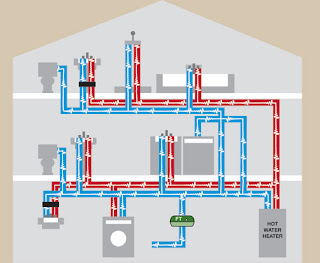In your 5-6 pm example, the pump would begin operating at 5 pm and begin circulating water so the WH will activate to heat the outgoing water to the set temperature. Once the crossover valve senses 95℉, the valve will close to stop flow. The hot water pipe feeding the crossiver valve will contain 95℉+ water. Although the pump will continue running, with no circulation path open, the water will not circulate so the WH will shut down until the water in the crossover valve cools to where the valve will open again to allow circulation.
Perhaps Noritz On-Demand kit will be comparable with your WH. The kit described here:
https://www.google.com/url?sa=t&source=web&rct=j&url=https://support.noritz.com/download.php?file=Literature%20Page/Installation%20Manual/IHK-NRCP%20IM.pdf&field=InstallationManual&ved=2ahUKEwi7oI-KgrHuAhVJbKwKHf9eDMsQFjAEegQICRAB&usg=AOvVaw232w_fjxojQMNEcx23BH6A
is intended for a dedicated return line, but I anticipate if you can feed a light gauge 2-wire cable (thermostat wire) to where the crossover valve is currently located, the sensor could be located there. The sensor will shut off the pump when sensing 102℉ so 7℉ greater than the crossover valve so removing the crossover valve would be necessary. The crossover valve could be replaced with an H shaped connection you build yourself, with a check-valve and ball valve in the cross over line between hot and cold to ensure flow is one direction only.
A 2-conductor cable routed to each bathroom, kitchen laundry and 2-piece connected to a momentary contact switch (door bell button) will activate the pump any time hot water use is anticipated. The Noritz manual linked above specifies On-Demand activation will allow the pump to run until the sensor senses 102℉ or 5-minutes, whichever is first.
Increasing the water temp to 102℉ will of course increase the temp of the cold water past the sensor, but 102℉ should continue to be reasonable.
https://www.homedepot.com/p/NORITZ-...ect-Tankless-Water-Heaters-IHK-NRCP/314025957

